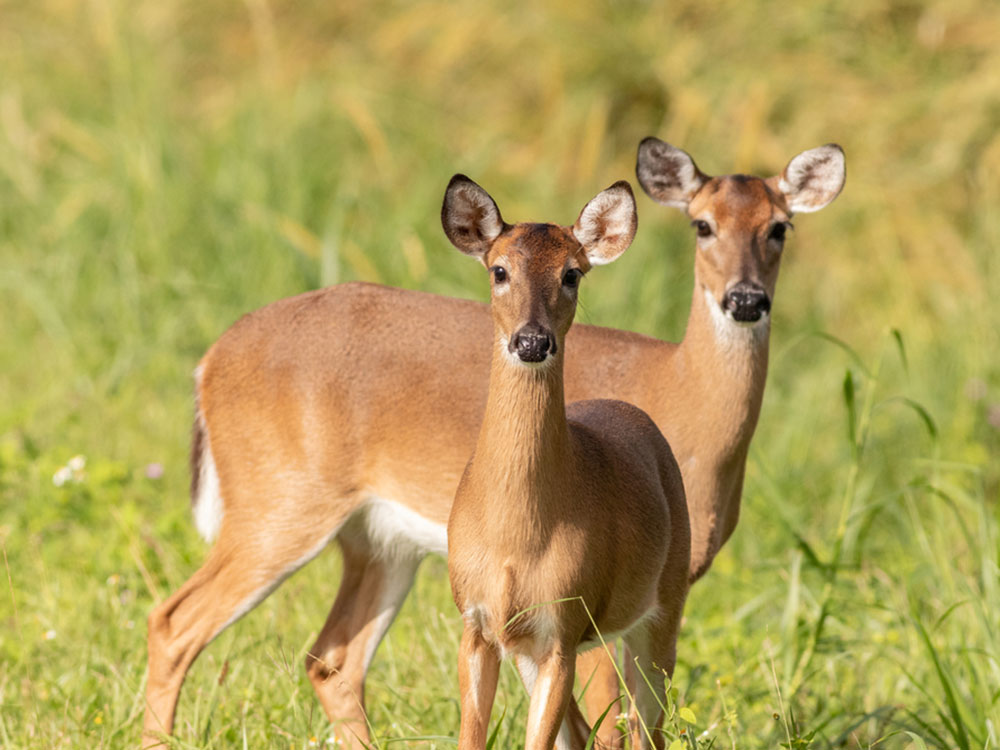COVID hasn’t just colonized billions of humans. The virus has entered North America’s white-tailed deer populations, transforming one of the largest remaining wild mammal populations on Earth into another rapidly evolving reservoir for COVID.
Scientists suspect that the deer picked up the virus via human feeding, garbage or wastewater containing the virus.
Whether cervids might someday spill a different variant back to people in a more deadly form remains an open question with uncertain implications.
Several new studies on COVID’s spread among deer recently shed more light on the scale of the development The Tyee first documented in 2021. They show that COVID not only has rapidly colonized deer, which share habitats with lots of other animals, but is now evolving at a faster rate than it is in humans.
In Ohio, for example, researchers analyzed more than 1,000 nasal swabs taken from that state’s wild deer populations. They found both a variety of COVID variants circulating in deer and frequent spillovers from humans into deer throughout the highly populated state.
In addition, about a quarter of the state’s deer population showed evidence of COVID infection at one time or another since the beginning of the pandemic.
The study found old variants such as Delta continued to reside in deer populations — long after they had disappeared from human populations.
Researchers also discovered that SARS-CoV-2 evolves three times faster in white-tailed deer than the rate observed in human populations. Different selection pressures and mutation biases appear to drive COVID evolution in deer.
Pathogens can jump back and forth between animals and human hosts and increasingly from humans into wildlife — a process known as reverse zoonosis.
The recently published findings have some experts worried that a particularly dangerous version of the virus may eventually evolve within the deer population and jump back into the human population.
If one of these variants were to be more deadly or immune evasive than the original virus, it could trigger a new pandemic.
“The sheer frequency of human-to-deer spillover observed in Ohio — and North America — is consistent with a growing consensus that cross-species transmission of SARS-CoV-2 occurs far more frequently than previously detected,” noted the study, published in Nature Communications.
Evolutionary biologist T. Ryan Gregory at the University of Guelph told The Tyee that he was not surprised by recent research findings.
“There’s no doubt that what evolves in another host species will be different, but whether it can move back into humans and compete well enough against our own variants to establish a new lineage, and whether it would be more immune evasive or more virulent, remains to be seen. In any case, less of the virus — in humans and non-humans — is better.”
More research needs to be done, noted the Ohio study. “The enigma of how SARS-CoV-2 transmits so frequently from humans to [white-tailed deer] reflects broad gaps in our understanding of SARS-CoV-2 ecology.”
Other deer studies raise the spectre that COVID variants researchers assume we’ve seen the last of may instead roost in wildlife, where they evolve into newer forms that once again make people sick in large numbers.
Potential ‘unique public health risks’
Deer “may serve as a reservoir for COVID variants such as Alpha, Delta and Gamma that no longer circulate in the human population” is the warning issued by authors of a study looking at the prevalence of COVID in deer in New York state.
A larger research program directed by the U.S. Department of Agriculture’s Animal and Plant Health Inspection Service, or APHIS, sampled more than 11,000 deer and found evidence of COVID infections in deer in half of the U.S. states between 2021 and 2022.
The researchers discovered that SARS-CoV-2 “was transmitted from humans to white-tailed deer at least 106 times in the United States, mutated, and then in three instances may have been transmitted back to humans.”
“Deer regularly interact with humans and are commonly found in human environments — near our homes, pets, wastewater and trash,” explained Dr. Xiu-Feng (Henry) Wan, a University of Missouri professor and director of the NextGen Center for Influenza and Emerging Infectious Diseases.
“The potential for SARS-CoV-2, or any zoonotic disease, to persist and evolve in wildlife populations can pose unique public health risks,” he said.
Scientists currently do not consider SARS-CoV-2 an important risk for North American livestock, but they acknowledge that the continued spread of the virus in human and white-tailed deer and other wildlife hosts could easily open new pathways for SARS-CoV-2 evolution.
The forests, suburbs and farms of North America now harbour more than 30 million white-tailed deer. That population increasingly lives in close quarters with human gardens and garbage. In addition, deer routinely mix with foxes, skunks and mice — wildlife also susceptible to infection.
No substantial outbreaks of deer-origin mutants spreading to humans have yet been reported. And the U.S. Department of Agriculture flatly states “there is no evidence that animals play a significant role in spreading the virus to humans.”
But it remains a possibility, as highlighted by a team of Canadian researchers in 2021.
They identified a new and highly divergent variant of SARS-CoV-2 in Ontario white-tailed deer and documented the first evidence of deer-to-human transmission.
The new variant was a descendant of an older, parental B.1 virus and possessed 76 mutations. In comparison, the Alpha, Beta and Delta variants had between 24 and 31 mutations.
“I was not expecting to find this highly divergent virus, which suggests that it has been circulating and evolving in deer for months and months,” said researcher Samira Mubareka, a member of the steering committee of the Emerging and Pandemic Infections Consortium based at the University of Toronto.
Perils of shrinking biodiversity
The ease with which COVID has travelled through white-tailed deer populations underscores the perils of diminishing biological diversity and the dominance of human activity on the planet.
Rising human populations have systemically reduced the number of wild mammals on Earth by intensively farming and industrializing landscapes over the last 250 years.
As a consequence, scientists calculate that humans and their livestock now represent 96 per cent of all living mammals on Earth. Wild mammals such as deer represent the remaining four per cent.
The picture becomes starker when expressed as global biomass. Recent scientific estimates say wild mammals probably represent 20 million tonnes while humans constitute 390 million tonnes and their livestock 690 million tonnes.
The total biomass of house cats now weighs double that of African elephants and four times that of moose.
As a consequence, about 40 per cent of the biomass of all wild land mammals is now concentrated in just 10 species. They include wild boar, warthog and five deer species. This concentration makes these populations more vulnerable to viral spillovers from human colonies and vice versa.
Researchers now estimate that the white-tailed deer has the highest overall biomass of all wild mammals left on the planet.
COVID in dogs
Scientists believe that the current pandemic began when the SARS-CoV-2 virus spilled over from wild bats into another, as yet unidentified mammal species or directly into humans sometime in the fall of 2019 in Wuhan City, where three separate laboratories house the largest collection of bat coronaviruses in the world.
Since then, the scientists have learned the virus can infect a variety of animals, including ferrets, cats, rabbits, dogs, tree shrews, hamsters and non-human primates such as macaques. Infected cats, tree shrews, hamsters and ferrets can spread the virus to people.
But the mustelid family of animals seems particularly susceptible to the virus and vulnerable to viral spillover. These carnivores include ferrets, badgers, raccoons, raccoon dogs, otters, martens, wolverines, mink and nearly 50 other species.
To date, a COVID infection does not appear to affect the health of white-tailed deer. But that is not the case for other animals such as dogs.
Korean scientists recently infected 15 beagles with the Delta variant. All had evidence of degenerative brain disease when autopsied.
“Our study provides evidence that SARS-CoV-2 infection can damage the brain as well as the lungs in dogs at early and later stages of infection, suggesting a high potential for a long-lasting COVID-19–like syndrome to develop in affected dogs,” conclude the researchers. ![]()
Read more: Health, Coronavirus

















Tyee Commenting Guidelines
Comments that violate guidelines risk being deleted, and violations may result in a temporary or permanent user ban. Maintain the spirit of good conversation to stay in the discussion and be patient with moderators. Comments are reviewed regularly but not in real time.
Do:
Do not: